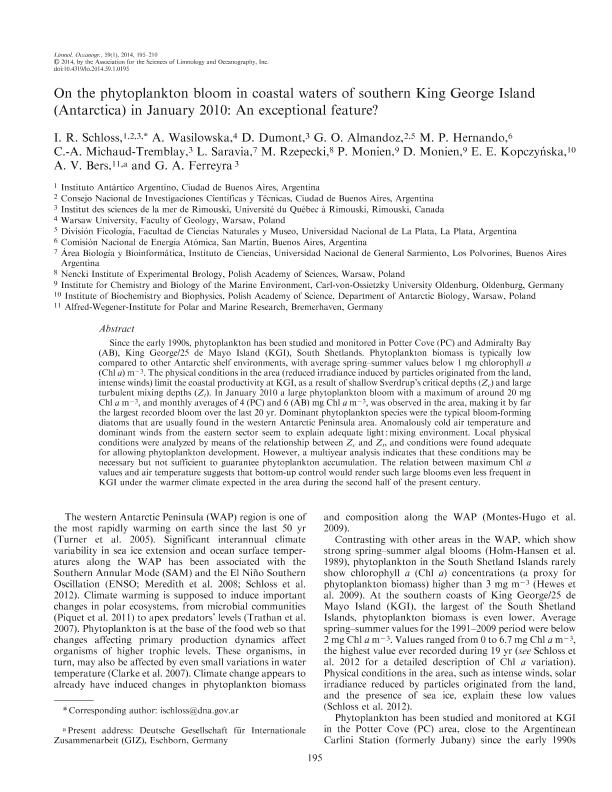Mostrar el registro sencillo del ítem
dc.contributor.author
Schloss, Irene Ruth

dc.contributor.author
Wasilowska, A
dc.contributor.author
Dumont, D
dc.contributor.author
Almandoz, Gaston Osvaldo

dc.contributor.author
Hernando, Marcelo Pablo

dc.contributor.author
Michaud Tremblay, C. A
dc.contributor.author
Saravia, L.
dc.contributor.author
Rzepecki, M.
dc.contributor.author
Monien, P.
dc.contributor.author
Monien, D.
dc.contributor.author
Kopczynska, E. E.
dc.contributor.author
Bers, A.V.
dc.contributor.author
Ferreyra, G. A.
dc.date.available
2017-09-21T17:08:39Z
dc.date.issued
2014-01
dc.identifier.citation
Schloss, Irene Ruth; Wasilowska, A; Dumont, D; Almandoz, Gaston Osvaldo; Hernando, Marcelo Pablo; et al.; On the phytoplankton bloom in coastal waters of southern King George Island (Antarctica) in January 2010: An exceptional feature?; Amer Soc Limnology Oceanography; Limnology and Oceanography; 59; 1; 1-2014; 195-210
dc.identifier.issn
0024-3590
dc.identifier.uri
http://hdl.handle.net/11336/24800
dc.description.abstract
Since the early 1990s, phytoplankton has been studied and monitored in Potter Cove (PC) and Admiralty Bay (AB), King George/25 de Mayo Island (KGI), South Shetlands. Phytoplankton biomass is typically low compared to other Antarctic shelf environments, with average spring—summer values below 1 mg chlorophyll a (Chl a) m−3. The physical conditions in the area (reduced irradiance induced by particles originated from the land, intense winds) limit the coastal productivity at KGI, as a result of shallow Sverdrup's critical depths (Zc) and large turbulent mixing depths (Zt). In January 2010 a large phytoplankton bloom with a maximum of around 20 mg Chl a m−3, and monthly averages of 4 (PC) and 6 (AB) mg Chl a m−3, was observed in the area, making it by far the largest recorded bloom over the last 20 yr. Dominant phytoplankton species were the typical bloom-forming diatoms that are usually found in the western Antarctic Peninsula area. Anomalously cold air temperature and dominant winds from the eastern sector seem to explain adequate light : mixing environment. Local physical conditions were analyzed by means of the relationship between Zc and Zt, and conditions were found adequate for allowing phytoplankton development. However, a multiyear analysis indicates that these conditions may be necessary but not sufficient to guarantee phytoplankton accumulation. The relation between maximum Chl a values and air temperature suggests that bottom-up control would render such large blooms even less frequent in KGI under the warmer climate expected in the area during the second half of the present century.
dc.format
application/pdf
dc.language.iso
eng
dc.publisher
Amer Soc Limnology Oceanography

dc.rights
info:eu-repo/semantics/openAccess
dc.rights.uri
https://creativecommons.org/licenses/by-nc-sa/2.5/ar/
dc.subject
Climate Change
dc.subject.classification
Bioquímica y Biología Molecular

dc.subject.classification
Ciencias Biológicas

dc.subject.classification
CIENCIAS NATURALES Y EXACTAS

dc.title
On the phytoplankton bloom in coastal waters of southern King George Island (Antarctica) in January 2010: An exceptional feature?
dc.type
info:eu-repo/semantics/article
dc.type
info:ar-repo/semantics/artículo
dc.type
info:eu-repo/semantics/publishedVersion
dc.date.updated
2017-09-18T14:28:54Z
dc.journal.volume
59
dc.journal.number
1
dc.journal.pagination
195-210
dc.journal.pais
Estados Unidos

dc.journal.ciudad
Wisconsin
dc.description.fil
Fil: Schloss, Irene Ruth. Ministerio de Relaciones Exteriores, Comercio Interno y Culto. Dirección Nacional del Antártico. Instituto Antártico Argentino; Argentina. Consejo Nacional de Investigaciones Científicas y Técnicas; Argentina. Université du Québec à Rimousk; Canadá
dc.description.fil
Fil: Wasilowska, A. Warsaw University; Polonia
dc.description.fil
Fil: Dumont, D. Université du Québec à Rimousk; Canadá
dc.description.fil
Fil: Almandoz, Gaston Osvaldo. Universidad Nacional de la Plata. Facultad de Ciencias Naturales y Museo. Division Ficología; Argentina. Consejo Nacional de Investigaciones Científicas y Técnicas; Argentina
dc.description.fil
Fil: Hernando, Marcelo Pablo. Comisión Nacional de Energía Atómica; Argentina
dc.description.fil
Fil: Michaud Tremblay, C. A. Université du Québec à Rimouski; Canadá
dc.description.fil
Fil: Saravia, L.. Universidad Nacional de General Sarmiento; Argentina
dc.description.fil
Fil: Rzepecki, M.. Polish Academy of Sciences; Argentina
dc.description.fil
Fil: Monien, P.. University Oldenburg; Alemania
dc.description.fil
Fil: Monien, D.. University Oldenburg; Alemania
dc.description.fil
Fil: Kopczynska, E. E.. Polish Academy of Sciences; Argentina
dc.description.fil
Fil: Bers, A.V.. Alfred-Wegener-Institute for Polar and Marine Research; Alemania
dc.description.fil
Fil: Ferreyra, G. A.. Université du Québec à Rimouski; Canadá
dc.journal.title
Limnology and Oceanography

dc.relation.alternativeid
info:eu-repo/semantics/altIdentifier/doi/http://dx.doi.org/10.4319/lo.2014.59.1.0195
dc.relation.alternativeid
info:eu-repo/semantics/altIdentifier/url/http://onlinelibrary.wiley.com/doi/10.4319/lo.2014.59.1.0195/abstract
Archivos asociados
